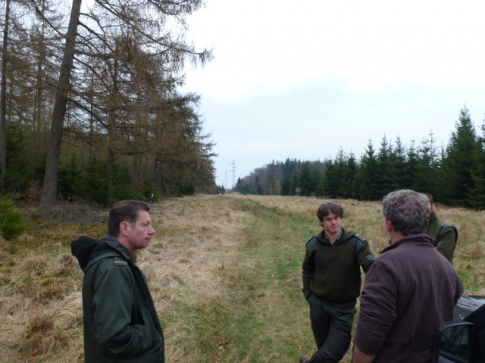News
2013-12-27
Ecological restoration under the Nassogne-Tenneville line (Luxembourg Province, Belgium)
A flagship site for the LIFE ELIA project
The Nassogne-Tenneville is the flagship site of the LIFE ELIA project. It was this very same place that inspired the genesis of the entire project.
Most of the electric line between Forrières and Herbaimont (Luxembourg Province, Belgium) crosses beautiful wooded lands. All along its 10 km route, history and legends merge into a scattered landscape with many places called la Fagne des Hérins, Sainte-Gertrude, la Fagne Massa et la Converserie. On the Saint-Hubert plateau, forests are mainly composed by beeches and spruces with a quite poor and sometimes absent undergrowth.
A striking idea for stakeholders was born !
During a safety campaign led in 2003 on the line, the idea of creating forest edges under the line just popped up. Creating a 'vegetation' transition between the surrounding forests and the flat safety electrical corridor had a powerful impact because it benefited to a wide range of actors involved in the countryside :
- public landowners (mainly municipality) caring about the beauty of the landscape
- Nature and Forest Administration sensitive to forest multifunctionality and to biodiversity
- hunters looking for the best conditions for the game
When the Transport System Operator moves on
Based on this idea, the ELIA company (Belgian Transport System Operator), proposed different actions to manage safety corridors differently. ELIA contracted a partnership with NGOs Solon asbl and CARAH on a wide project : the LIFE ELIA. Ideas of field actions sprouted such as creating forest edges, ponds, peats, old species plantations, simple flower meadows...the Nassogne-Tenneville section was about to be transformed. The following link provides a good overview of works achieved under the line : https://qgiscloud.com/jfgodeau/Travaux_NassTenn_Simplifixc3xa9_NEWS
A 4 steps methodology
The work started by a 'vegetation' mapping of the section Nassogne-Tenneville. The second step consisted in a dialogue with local stakeholders (ELIA, landowners, Administration, hunters).


Then agreements were concluded to plan field works and administrative documents were filled out such as management plans, municipality agreements and work authorisation. Eventually, call for tenders were sent to specialized companies.
On site works
Things are moving in the Tenneville's woods, preliminary on site works linked to edges are starting. The « Pirothon » company was responsible for the soil preparation by rotary milling.


Mid October 2013, plantations were carried out by « Bois-Jardin » company.
In the overall, 30.000 brush plants were planted. Among the species selected were : hazel tree, round-ear willow, blackthorn, rowan tree, alder buckthorn, red elderberry, elder, cranberry bush, wild apple trees and wild pear trees.


A voluntary day has been organised with the members of the NGO Solon. The task was to enrich edges with apple and pear trees form our nurseries and to supplement some plantations with round ear willows cuttings.




For the game pressure on pear and apple trees being too high, their plantation has to go along with protection.
Therefore, those attractive plants will be only planted within fenced areas. These fences will be placed by the « Neuville » company.

Another fence, another objective
An existing pasture has been extended to the area under the electrical lines, making an extra 3 ha to pasture on. The management of this safety corridor will be undertaken by some lovely scottich cows.

And other works carried out
Further on the same section, the nature service provider « Philippe Mignon » has undertaken the heavy soil scratching and ponds digging. Around 30 ponds were digged all along the safety corridor. Each pond is between 25 and 125 m2 big. They will allow dragonflies, amphibians and birds to find good conditions.

Besides, soil scratching were made on meadows dominated by Molinia caerulea and other graminales. The final objective is to withdraw a thin layer of soil in order to create the best conditions for the soil seedbank to germinate, or in some situation, to sow a mix of seeds from flowered meadows.

et
Actions will take place until spring. In the overall, around 30 ha of green corridors will be created. Let's hope drastic changes for biodiversity will be monitored !










